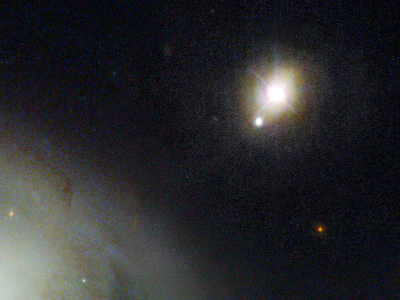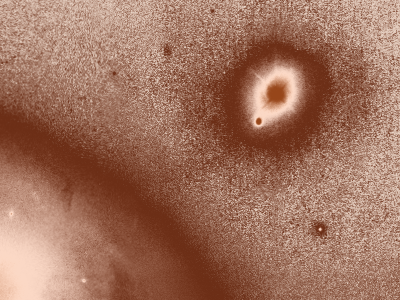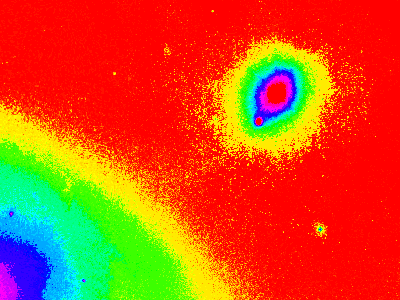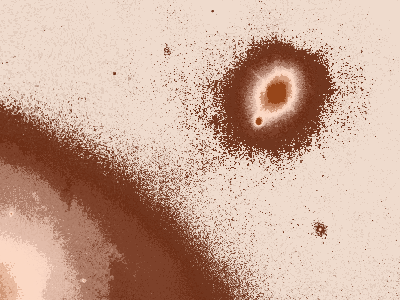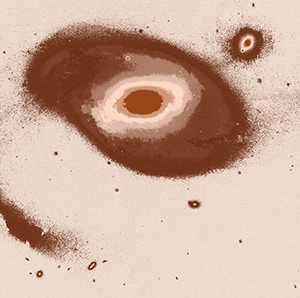 The Seyfert galaxy NGC 7603 and its companion NGC 7603B (PGC 07041) was a close contender for my first post of discordant redshift examples. Ultimately NGC 4319 and Markarian 205 won out because it not only showed a visible connection between two discordant redshift objects but it represents a perfect example of denial and possibly even suppression by NASA and the scientific community. NGC 7603 and 7603B is actually a better example of connected discordant redshift objects. But the connection is so overwhelming obvious there can be no real denial or suppression of its existence. The photograph to the right shows the larger galaxy NGC 7603 clearly connected to its smaller companion galaxy NGC 7603B via a curved bridge of matter. The photograph is unaltered as downloaded from the Sloan Digital Sky Survey SkyServer website. The redshifts of the two objects have been known for some time and are discussed in Dr. Halton Arp’s books Quasars, Redshifts and Controversies (Interstellar Media, 1987) and Seeing Red: Redshifts, Cosmology and Academic Science (Apeiron, 1998). In fact, this group of objects was included as Arp 92 in Dr. Arp’s Atlas of Peculiar Galaxies published by Caltech in 1966. The redshift of the spectrum of NGC 7603 as listed in NED is 0.029524 z which would place it at a distance of over 500 million light-years from Earth using a so-called Hubble Constant value of 55 (km/s)/Mpc. However the redshift of NGC 7603B as listed in NED is 0.055742 z which would supposedly place it at almost twice that distance at over 950 million light years from Earth. It is unequivocal that the redshifts of these two visibly connected objects do not indicate distance unless one wants to entertain the notion that the bridge of connecting matter is over 450 million light-years in length.
The Seyfert galaxy NGC 7603 and its companion NGC 7603B (PGC 07041) was a close contender for my first post of discordant redshift examples. Ultimately NGC 4319 and Markarian 205 won out because it not only showed a visible connection between two discordant redshift objects but it represents a perfect example of denial and possibly even suppression by NASA and the scientific community. NGC 7603 and 7603B is actually a better example of connected discordant redshift objects. But the connection is so overwhelming obvious there can be no real denial or suppression of its existence. The photograph to the right shows the larger galaxy NGC 7603 clearly connected to its smaller companion galaxy NGC 7603B via a curved bridge of matter. The photograph is unaltered as downloaded from the Sloan Digital Sky Survey SkyServer website. The redshifts of the two objects have been known for some time and are discussed in Dr. Halton Arp’s books Quasars, Redshifts and Controversies (Interstellar Media, 1987) and Seeing Red: Redshifts, Cosmology and Academic Science (Apeiron, 1998). In fact, this group of objects was included as Arp 92 in Dr. Arp’s Atlas of Peculiar Galaxies published by Caltech in 1966. The redshift of the spectrum of NGC 7603 as listed in NED is 0.029524 z which would place it at a distance of over 500 million light-years from Earth using a so-called Hubble Constant value of 55 (km/s)/Mpc. However the redshift of NGC 7603B as listed in NED is 0.055742 z which would supposedly place it at almost twice that distance at over 950 million light years from Earth. It is unequivocal that the redshifts of these two visibly connected objects do not indicate distance unless one wants to entertain the notion that the bridge of connecting matter is over 450 million light-years in length.
Upon closer inspection of the above photograph two smaller points of light can be seen embedded within the connecting bridge of matter between the two galaxies, one near each end of the bridge. The SkyServer site describes these objects as stars but close examination of their spectra and the spectra of the bridge itself reveals something much more intriguing. On June 13, 2000 astronomers Martin López-Corredoira and Carlos M.  Gutiérrez took a detailed R-band (near infrared) photograph of NGC 7603 and NGC 7603B using the 2.6 meter Nordic Optical Telescope on the island of La Palma in the Canary Islands. They then followed up with a detailed spectroscopic analysis of the bridge of matter and embedded point objects on August 12, 2001. The image on the left is taken from their report in Astronomy & Astrophysics and has been unaltered accept for a size reduction to better fit it on this page.
Gutiérrez took a detailed R-band (near infrared) photograph of NGC 7603 and NGC 7603B using the 2.6 meter Nordic Optical Telescope on the island of La Palma in the Canary Islands. They then followed up with a detailed spectroscopic analysis of the bridge of matter and embedded point objects on August 12, 2001. The image on the left is taken from their report in Astronomy & Astrophysics and has been unaltered accept for a size reduction to better fit it on this page.
The top half of the image shows a 15-minute exposure of NGC 7603 and NGC 7603B (Object 1) in near infrared light (0.7-1.0 µm) and their redshifts which, including their range of deviation, closely match the measurements listed in NED for the two objects. Of course the most important discovery in their observations was that the two star-like objects were indeed quasars with high redshifts of 0.243 z and 0.391 z. If redshifts really did indicate distance this would place Object 2 at over 3.6 billion light-years from Earth and Object 3 at over 5.4 billion light-years respectively using a so-called Hubble Constant value of 55 (km/s)/Mpc.
The bottom half of the image shows a close-up of the bridge of matter, referred to as “filament” in the A&A report. The dotted lines indicate the 5 arcsecond-wide slit in the spectrograph where the spectra of all three objects including sections of the filament itself were taken. As can be seen, the redshift of the filament almost exactly matches the redshift of NGC 7603 which clearly demonstrates that the bridge of connecting matter is part of that galaxy. But most importantly this detailed view shows that regardless of the extreme distances attributed to Objects 2 and 3 because of their redshifts they are indeed embedded in the filament of matter connecting NGC 7603 and Object 1 (NGC 7603B). In fact, this detailed view shows a bulge of material extending from the right side of NGC 7603B into the connecting filament and ending at the left edge of Object 2. There is also clearly a stream of material extending out from the bottom of NGC 7603 into the filament and ending at the right edge of Object 3.
You would think that the discovery of such an obvious group of vastly discordant redshifts would have garnered some sort of response from the mainstream scientific community, whether positive or negative. But unless you count the rejection of the findings by Nature and the Astrophysical Journal, there has been mostly silence. So far these observations by López-Corredoira and Gutiérrez have not been referenced in any mainstream science journals or publications, particularly by astronomers in the United States. It is very fortunate that their findings were published at all. All scientists and lovers of science should be thankful that the European Astronomy and Astrophysics Journal had the courage to do so, albeit with some help from an “anonymous” referee.
For more information regarding the NGC 7603 system and its history of rejection by the scientific community I recommend reading the works of Halton Arp mentioned above and the introduction to Jeff Kanipe and Dennis Webb’s book The Arp Atlas of Peculiar Galaxies (Willmann-Bell, 2006). Do you have questions or comments about this example? Do you have an example you would like to contribute? Your input is not only welcomed, it is encouraged.
Thanks for reading!
Shannon

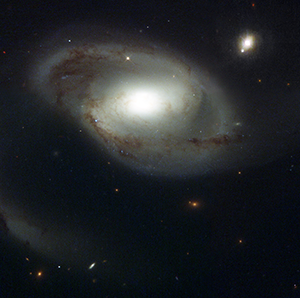 Ironically, my first posted example of discordant redshifts could really serve as the one and only example I should have to post. It is not only one of the best examples of visibly connected extragalactic objects possessing two widely different redshifts, it is also a perfect example of the current scientific community’s blatant refusal to acknowledge obvious observational evidence. The photograph to the left shows the barred spiral galaxy NGC 4319 with the nearby quasar Markarian 205 to the upper right. I reduced the image size of the original uncompressed TIFF file and saved it as an image file in PNG format in order to fit it on this page and avoid any compression artifacts. I also saved all subsequent modifications of the image in PNG format to avoid compression artifacts. The original photograph can be freely downloaded in many different formats and sizes from the
Ironically, my first posted example of discordant redshifts could really serve as the one and only example I should have to post. It is not only one of the best examples of visibly connected extragalactic objects possessing two widely different redshifts, it is also a perfect example of the current scientific community’s blatant refusal to acknowledge obvious observational evidence. The photograph to the left shows the barred spiral galaxy NGC 4319 with the nearby quasar Markarian 205 to the upper right. I reduced the image size of the original uncompressed TIFF file and saved it as an image file in PNG format in order to fit it on this page and avoid any compression artifacts. I also saved all subsequent modifications of the image in PNG format to avoid compression artifacts. The original photograph can be freely downloaded in many different formats and sizes from the 